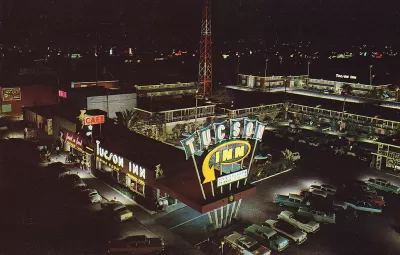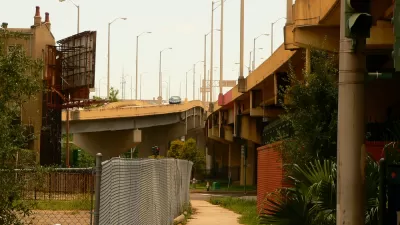After tremendous success with a streetcar line, the desert city is considering strategies for investing in its historic automobile corridor.

Four years ago, the Sunlink streetcar began running a route originating at the University of Tucson, along 4th Avenue, through downtown, and to the Mercado District. With its success came the kind of business and residential activity seen in other cities that have invested in transit, to the point where, four years later, formerly desolate areas are concerned.
Other areas of Tucson have not fared as well, namely what was once referred to as the Miracle Mile, a stretch of road on the north side of the city that once served as an "automobile gateway.
"With its Old Spanish Trail marketing, Tucson was one of the first cities to promote automobile-based tourism," Gideon Berger writes at CitiesSpeak. "As vehicle ownership skyrocketed in the 1920s, business catering to 'auto-camping' tourists flourished along corridors leading to the city. Eventually, these grew to include 'motor courts' with cabin lodging and some of the nation’s first motels."
Like similar areas in other American cities, the construction of an interstate highway—in this case I-10—Miracle Mile sent the neighborhood into decline.
After its recent success in redevelopment, Tucson won a land use fellowship from the Rose Center for Public Leadership and has revisited the Miracle Mile.
Berger, who is the director of the program for the Rose Center, enumerates a lengthy list of areas for which the fellowship developed recommendations, including both economic and cultural development and protecting residents from the kind of displacement that this sort of development can mean for those who live in it.
FULL STORY: Can Tucson, Arizona Bring Back its Miracle Mile?

Study: Maui’s Plan to Convert Vacation Rentals to Long-Term Housing Could Cause Nearly $1 Billion Economic Loss
The plan would reduce visitor accommodation by 25,% resulting in 1,900 jobs lost.

North Texas Transit Leaders Tout Benefits of TOD for Growing Region
At a summit focused on transit-oriented development, policymakers discussed how North Texas’ expanded light rail system can serve as a tool for economic growth.

Why Should We Subsidize Public Transportation?
Many public transit agencies face financial stress due to rising costs, declining fare revenue, and declining subsidies. Transit advocates must provide a strong business case for increasing public transit funding.

How to Make US Trains Faster
Changes to boarding platforms and a switch to electric trains could improve U.S. passenger rail service without the added cost of high-speed rail.

Columbia’s Revitalized ‘Loop’ Is a Hub for Local Entrepreneurs
A focus on small businesses is helping a commercial corridor in Columbia, Missouri thrive.

Invasive Insect Threatens Minnesota’s Ash Forests
The Emerald Ash Borer is a rapidly spreading invasive pest threatening Minnesota’s ash trees, and homeowners are encouraged to plant diverse replacement species, avoid moving ash firewood, and monitor for signs of infestation.
Urban Design for Planners 1: Software Tools
This six-course series explores essential urban design concepts using open source software and equips planners with the tools they need to participate fully in the urban design process.
Planning for Universal Design
Learn the tools for implementing Universal Design in planning regulations.
City of Santa Clarita
Ascent Environmental
Institute for Housing and Urban Development Studies (IHS)
City of Grandview
Harvard GSD Executive Education
Toledo-Lucas County Plan Commissions
Salt Lake City
NYU Wagner Graduate School of Public Service





























